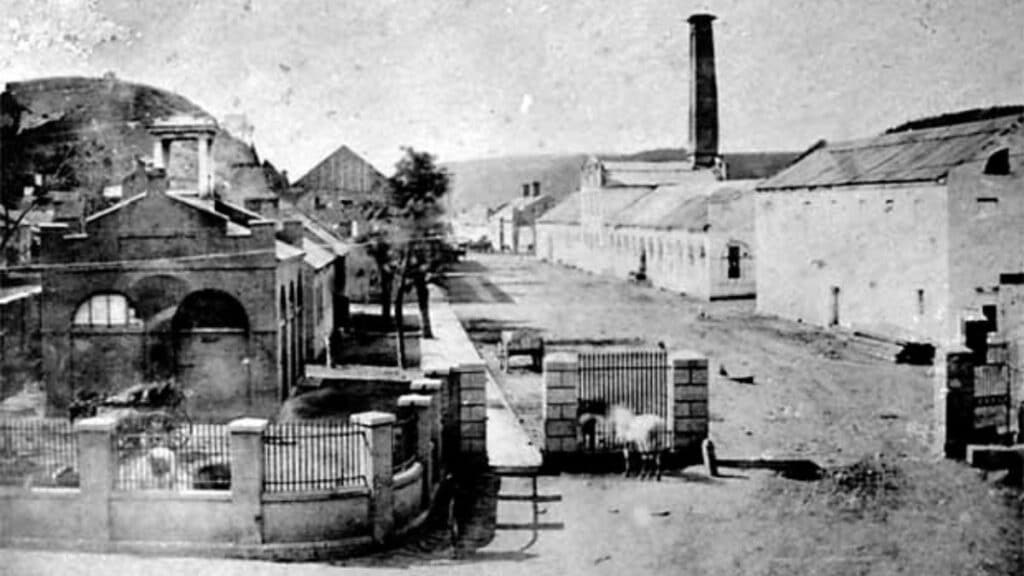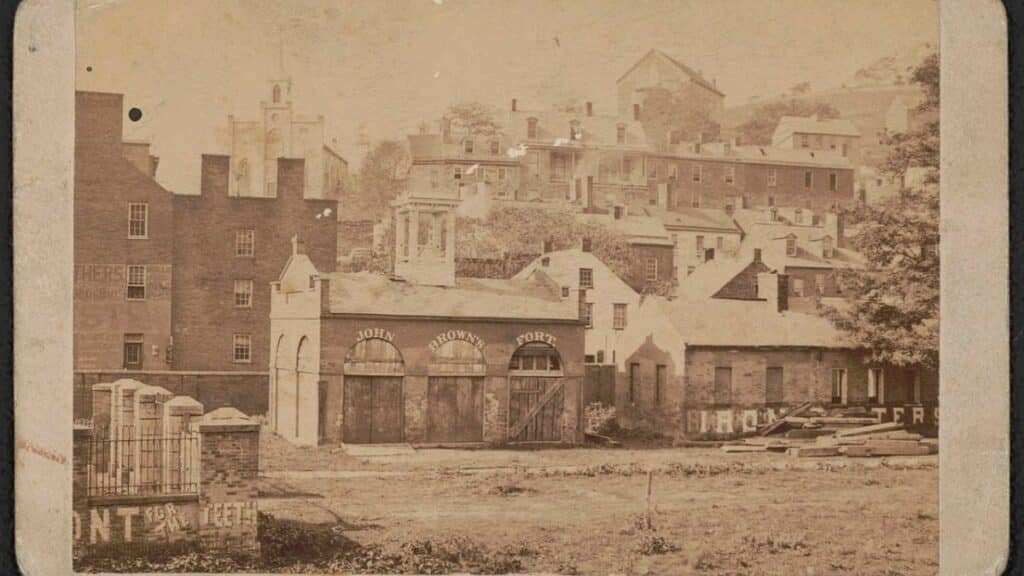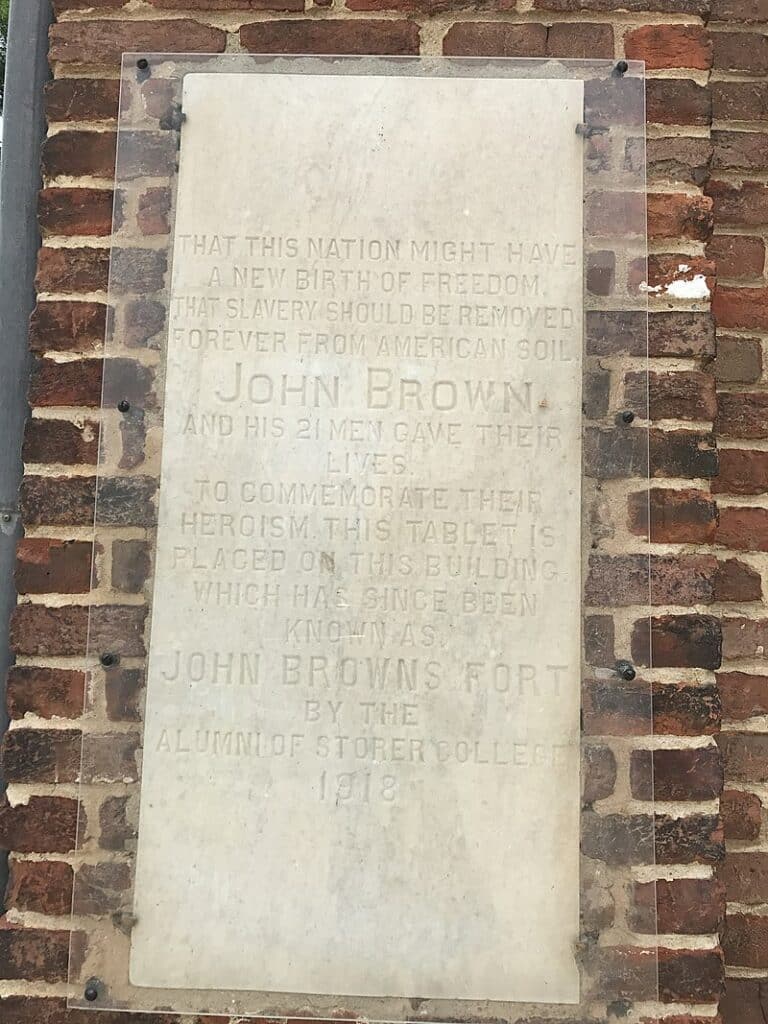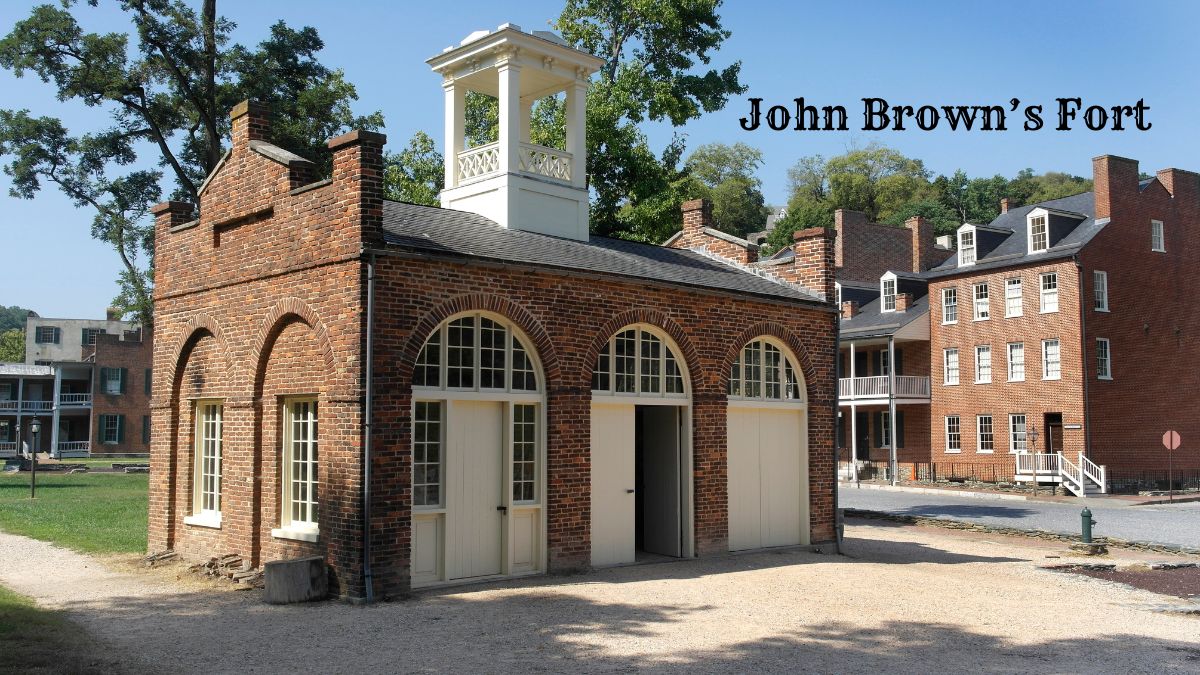John Brown’s Fort is a landmark deeply intertwined with American history and the fight against slavery.
Situated in Harpers Ferry, it became a focal point during the abolitionist movement, most notably during John Brown’s daring raid in 1859.
This event, which aimed to spark a slave uprising, significantly influenced national tensions leading up to the Civil War.
The fort’s important history extends beyond the raid. It has been preserved and relocated multiple times to maintain its legacy.
Today, it symbolizes the enduring struggle for freedom and equality, attracting visitors and scholars interested in its rich past and impact on civil rights.
History of John Brown’s Fort

John Brown’s Fort is a critical symbol in American history, closely linked with abolitionist movements, the raid on Harpers Ferry, and its pivotal role in the Civil War.
John Brown and Abolitionist Movements
John Brown was a fervent abolitionist who believed in the immediate emancipation of all enslaved people. He was involved in violent and nonviolent actions to combat slavery.
Brown’s moral conviction led him to take drastic measures, asserting that militant action was necessary to end slavery.
His efforts were amplified through his speeches and writings, rallying support among abolitionists.
Brown’s commitment significantly influenced public opinion, making him both a hero and a villain in the eyes of different communities.
John Brown’s Raid on Harpers Ferry
In October 1859, John Brown led a raid on the federal armory at Harpers Ferry, Virginia (now West Virginia). His aim was to initiate a slave uprising by arming enslaved individuals.
The raid, however, failed, with Brown and several of his men captured or killed.
The event intensified national tensions and polarized opinions on slavery. It demonstrated the lengths to which abolitionists would go to fight for freedom and how deeply entrenched the issue of slavery had become in the nation.
Role in the Civil War
John Brown’s Fort became a symbolic site during the Civil War. Union and Confederate forces alternately occupied it, with its legacy as a beacon of anti-slavery sentiment ever-present.
The fort’s association with Brown’s raid kept the abolitionist cause at the forefront of minds during the conflict.
The fort’s preservation and continued existence serve as a testament to the central role that the struggle against slavery played in the Civil War and in shaping the United States’ history.
The architecture of John Brown’s Fort

John Brown’s Fort has a rich history characterized by its original location, multiple relocations, and extensive restoration efforts.
Original Location and Structure
The fort was initially situated in Harpers Ferry, West Virginia, within the Harpers Ferry Armory grounds. Constructed in 1848, it was a fire engine house for the armory.
The brick building measured 35 by 24 feet. Its front and rear walls had two floors and three large archways.
Key Features:
- Built with durable brick
- Arched doorways for easy access
- Engine house design catered to housing fire engines
The foundation was strong and designed to support heavy machinery used in the armory.
Relocations and Present-Day Site
John Brown’s Fort has been relocated several times since its original use in the raid. This movement began in 1891 when it was taken to Chicago for the World’s Columbian Exposition.
It returned to Harpers Ferry in 1895, albeit not to its original location.
Present-Day Site:
- Now situated about 150 feet from its initial site
- Lies within the Harpers Ferry National Historical Park
- Coordinated by the National Park Service
These numerous relocations have taken a toll on the structure, necessitating significant restorative efforts over the years.
Restoration Efforts
Extensive restoration efforts have been undertaken to preserve the fort’s historical integrity.
Managed by the National Park Service, these initiatives included replacing missing bricks and reinforcing the foundation.
Restoration Challenges:
- Maintaining the historical accuracy
- Using period-appropriate materials
- Structural repairs while preserving original design
Recent efforts focus on ensuring the building remains a permanent fixture for educational purposes and historical tourism.
Cultural Impact and Public Memory

John Brown’s Fort is significant in cultural history, influencing various facets such as museum exhibitions, media representations, and educational endeavors.
These aspects highlight the fort’s historical importance and the continued relevance of John Brown’s legacy.
Museum Exhibitions
John Brown’s Fort is a major attraction at Harpers Ferry National Historical Park. The fort’s history is often showcased in thematic exhibits featuring artifacts related to Brown’s raid and abolitionist movements.
Museums in Chicago and other cities have incorporated the fort into larger discussions about the Civil War. Parts of the fort were famously displayed at the 1893 Columbian Exposition in Chicago, drawing nationwide attention.
Such displays encourage public engagement and help contextualize the fort’s role in American history. Storer College, located near Harpers Ferry, also played a critical role in preserving the fort’s legacy, often highlighted in museum narratives.
Media and Literature
John Brown’s Fort has been extensively covered in literature and media. Numerous books, articles, and documentaries have explored Brown’s raid and its impact on American society.
A notable author and journalist, Kate Field wrote compellingly about the fort, bringing its story to a wider audience. Many abolitionist publications featured the fort prominently, highlighting its symbolic importance in the fight against slavery.
Films and television series focusing on the pre-Civil War era often reference or feature the fort, further embedding it in the public consciousness. Media portrayals help keep the history and significance of John Brown’s Fort alive.
Educational Initiatives
Educational programs focusing on John Brown’s Fort are integral to understanding American history.
Schools and universities incorporate the fort’s history into curricula to discuss broader themes like abolition and civil rights.
Storer College was instrumental in promoting the education of African Americans and often used the fort as a teaching tool. Educational initiatives at the college included field trips and lectures centered on the fort’s history.
Modern educational projects utilize technology to create interactive experiences, making learning about the fort accessible and engaging. These initiatives ensure that new generations appreciate the fort’s historical significance.
John Brown’s Fort in the Context of Slavery
The significance of John Brown’s Fort is deeply rooted in its connection to slavery and the events that occurred during John Brown’s Raid.
The Siege and its Prisoners

John Brown’s Raid took place on October 16, 1859, targeting the federal armory in Harpers Ferry, Virginia. John Brown and 21 of his followers seized the armory and took several hostages, intending to incite a slave rebellion.
Enslaved people and townsmen were among the captives held inside the Guard House and Powder Magazine.
Local militia and federal troops, led by Colonel Robert E. Lee, quickly responded.
The siege lasted two days and culminated in a violent clash, ultimately breaching the stronghold. Brown and his men were captured or killed, highlighting the stark divisions over slavery.
Aftermath: Trials and Sentencing
Following the raid, Brown and the surviving participants were transported to Charles Town, Virginia, to face charges. The trial was brief and highly publicized, drawing intense national attention.
Brown was charged with treason against the state of Virginia, inciting a slave insurrection, and murder.
On November 2, 1859, John Brown was found guilty. He was sentenced to death and executed by hanging on December 2, 1859.
The harsh punishment underscored the volatile debate over slavery and its enforcement through extreme judicial measures.
Slavery and the Road to War
John Brown’s actions at the fort intensified the national conversation about slavery’s morality and future in America.
The raid and the subsequent crackdown by authorities showcased the lengths to which abolitionists would go and the brutal resistance of pro-slavery forces.
The raid polarized the nation, encouraging abolitionists and terrifying Southern slaveholders. It accelerated the nation’s march toward the Civil War, making it clear that the conflict over slavery could not be resolved peacefully.
John Brown’s Fort thus became a symbol of the violent struggle that would soon engulf the country.
Preservation and Commemoration Efforts
John Brown’s Fort holds significant historical value and has sparked extensive preservation and commemoration efforts.
These efforts include fundraising activities, its status as a symbol, and its association with modern civil rights movements.
Fundraising Drives and Public Support
Extensive fundraising drives and public backing have supported efforts to preserve John Brown’s Fort.
Organizations have initiated campaigns to gather donations from individuals and groups dedicated to maintaining this historic site.
Funds raised have often gone towards structural repairs, such as replacing the slate roof, installing copper gutters, and repairing downspouts.
Public support is also crucial, as visitors frequently purchase souvenirs, contributing to ongoing maintenance.
John Brown’s Fort as a Symbol
John Brown’s Fort has become a symbol of resistance and the fight for freedom. Originally a small fire engine house, it now represents the enduring spirit of those who stood up against slavery.
Numerous commemorative events are held at the site to honor its historical significance.
This symbolic status has led to various scholarly articles, public speeches, and exhibitions highlighting its role in American history’s broader narrative.
Role in Modern Civil Rights Movements
John Brown’s Fort continues to resonate in modern civil rights movements.
In 1906, members of the Niagara Movement held their annual meeting at the fort, underscoring its importance as a historical site of activism.
Today, it serves as a venue for events and discussions focused on civil rights issues. By linking past struggles with present-day challenges, the fort remains a powerful symbol of ongoing efforts to achieve equality and justice.
Martial and Strategic Aspects
The significant events around John Brown’s Fort highlight the interventions by various military forces, the roles of different combatants, and the situations faced by hostages.
Assault by U.S. Marines
Under the command of Lieutenant Colonel Robert E. Lee, the U.S. Marines launched a decisive assault on John Brown’s Fort.
Brown and his followers used the fort as a stronghold, expecting to incite a slave uprising.
Armed with rifles and guns, Brown’s men resisted but were outnumbered and outgunned.
Lee, already a respected military figure, led the well-coordinated attack.
A battering ram was employed to force entry, resulting in intense close-quarters combat.
The Marines’ superior training and equipment quickly overwhelmed Brown’s defense, leading to his capture and the end of the siege.
Militia and Military Responses
In addition to the Marines, various militia and local military units played crucial roles in responding to the crisis.
Union troops were dispatched to maintain order and protect the federal Arsenal.
The local militia, comprising both Union and Confederate sympathizers, quickly mobilized to confront Brown’s force.
These units ensured that the situation was contained and prevented any potential spillover of violence into the surrounding areas.
Their swift cooperation with federal forces exemplified the seriousness with which the threat was taken.
Combatants and Hostages
John Brown’s raid involved a mix of combatants, including his followers and residents who were either sympathetic or vehemently opposed to his cause.
Brown’s group consisted of white abolitionists and freed African Americans, who were prepared for armed resistance.
Hostages taken by Brown were primarily local citizens whom he hoped to use as leverage.
The hostages’ plight added complexity to the military responses, as the authorities aimed to secure their release while neutralizing the threat posed by Brown’s group.
The hostages were eventually freed following the successful assault by the Marines.
Explore More: 11 Historic Forts in West Virginia: An Amazing Historical Insight
John Brown’s Fort in History
John Brown’s Fort is deeply intertwined with significant moments in American history, from the Civil War through Reconstruction and beyond. Its connections to critical historical events showcase its lasting influence on the nation.
Connections to Other Historical Events
John Brown’s Fort, originally constructed in 1848, was intended as a fire engine house for the U.S. Army’s arsenal in Harpers Ferry, Virginia (now West Virginia).
John Brown and his followers captured it in 1859 alongside Arsenal Square during their raid, aiming to ignite a major slave revolt. This incident was a precursor to the Civil War, highlighting the fierce opposition to slavery.
The fort later served multiple roles, including a Quartermaster Supply House and a supply house during the Civil War. Its strategic importance made it a focal point during the conflict.
The World’s Columbian Exposition in 1893 saw the fort displayed to symbolize the struggle for freedom and justice, further cementing its historical significance.
Influences on Post-War America
Following the Civil War, John Brown’s Fort remained a powerful symbol in the Reconstruction era.
It was associated with the push for civil rights and justice for African Americans, who saw Brown’s actions as a catalyst for change.
Abolitionists and civil rights activists, including Frederick Douglass, referenced the raid to advocate for equality and the abolition of racial injustices.
The fort’s presence in Harpers Ferry eventually became a landmark for those retracing Brown’s steps and his fight against slavery.
The U.S. Army’s involvement in the fort’s various roles highlighted broader military and social changes during Reconstruction.
Legacy in American History
John Brown’s Fort is a significant historical landmark with an enduring legacy.
It is a reminder of the abolitionist movement and the broader fight for human rights.
The fort has been preserved and now serves educational purposes. Visitors can explore its history via the Shuttle Bus Stop near the Appalachian Trail.
Its relocation to Harpers Ferry National Historical Park ensures that its story continues to be told.
The fort’s influence extends beyond its original function. It embodies the resilience and dedication of those who fought for freedom and justice.
Frequently Asked Questions
John Brown’s Fort is a significant historical site tied to the events of John Brown’s raid on Harpers Ferry. Here are some commonly asked questions and their answers:
What is the historical significance of John Brown’s Fort?
John Brown’s Fort was originally a firehouse and became famous for its role in the 1859 raid led by abolitionist John Brown. This event aimed to initiate an armed slave revolt by capturing the US Arsenal at Harpers Ferry.
How can one obtain tickets to visit John Brown’s Fort?
Tickets can be purchased through the official Harpers Ferry National Historical Park website or at the park’s visitor center.
Reservations are recommended, especially during peak tourist seasons.
What is the value of the 2016 John Brown’s Fort Quarter?
The 2016 John Brown’s Fort Quarter is part of the America the Beautiful Quarters series.
While its face value is 25 cents, the collectible value might vary based on its condition and market demand. Collectors should consult a numismatic guide or dealer.
Are there guided tours available at John Brown’s Fort, and how can they be booked?
The National Park Service offers guided tours, which can be booked online via the Harpers Ferry National Historical Park website.
Tours provide detailed historical contexts and insights into the site.
What events transpired at John Brown’s Fort during the raid?
During the October 16, 1859 raid, John Brown and his followers seized the fort as part of their attack on the federal armory. After a two-day standoff, they were captured by US Marines led by Colonel Robert E. Lee.
What was the outcome of John Brown’s raid on Harpers Ferry?
The raid ultimately failed to start a slave uprising.
John Brown was captured, tried for treason, murder, and inciting a slave rebellion, and was subsequently executed.
The event, however, heightened national tensions leading up to the Civil War.

Cory is a website owner and content creator who enjoys fishing, history, coin collecting, and sports, among other hobbies. He is a husband and father of four.
Romans 15:4 For whatever was written in former days was written for our instruction, that through endurance and through the encouragement of the Scriptures we might have hope.

